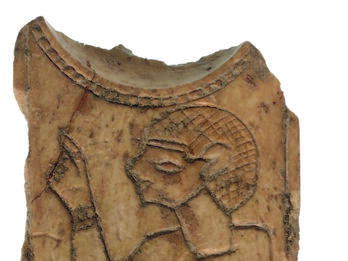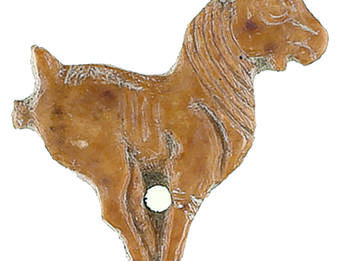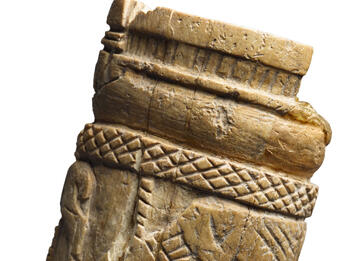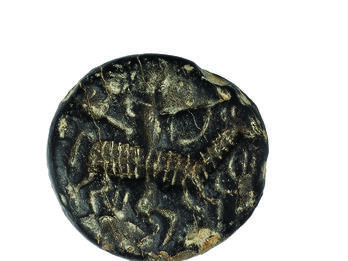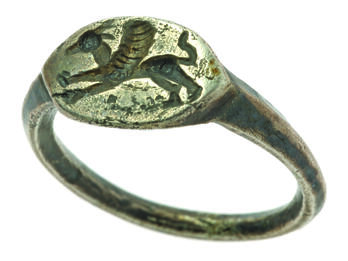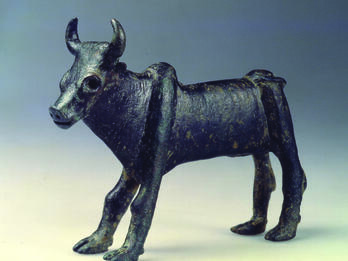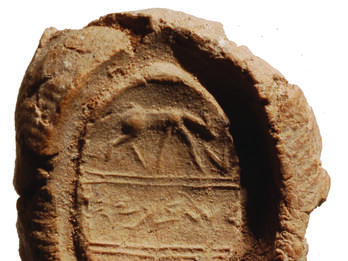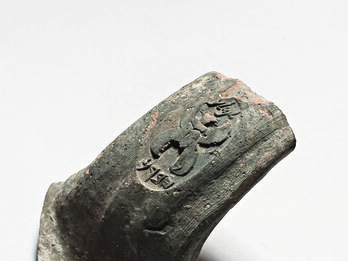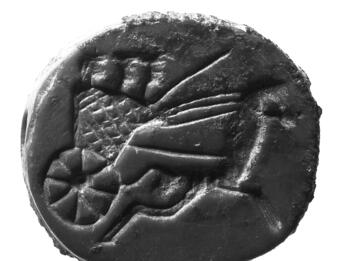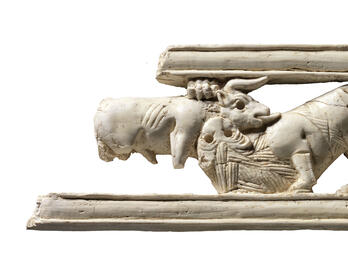Showing Results 1 - 10 of 41
Restricted
Image
This spoon from Hazor has a wide handle intricately incised on its front with a sequence of palmettes curving upward instead of the more common downward-turning volutes. The spoon’s use is unclear. It…
Places:
Hazor, Land of Israel (Tel Hazor, Israel)
Date:
Iron Age II, 8th Century BCE
Subjects:
Categories:
Restricted
Image
In this ivory inlay, found in Jerusalem (Ophel), incised lines indicate the goat’s fur, especially around the neck, and deeper lines detail the legs. The goat’s feet are all very close together…
Places:
Jerusalem, Land of Israel (Jerusalem, Israel)
Date:
Iron Age IIA, 10th–9th Century BCE
Subjects:
Categories:
Restricted
Image
The primary register of this handle from Hazor shows two grazing caprids (perhaps deer or gazelles), a popular motif (see “Bulla of Shebanyahu Son of Samak, with Grazing Doe”). Beneath them is a…
Places:
Hazor, Land of Israel (Tel Hazor, Israel)
Date:
Iron Age IIB, first Half of 8th Century BCE
Subjects:
Categories:
Restricted
Image
This stamp seal depicts an archer shooting at a fleeing quadruped, possibly an antelope. The action is difficult to make out. From the viewer’s perspective the archer is behind the animal while the…
Places:
Moza, Land of Israel (Motsa, Israel)
Date:
Iron Age IIA, Late 10th–Early 9th Century BCE
Subjects:
Categories:
Restricted
Image
Silver signet ring with image of galloping griffin, a hybrid creature that consists of feline body and legs, avian head and wings, and serpentine tail. Found in a burial cave in the Ketef Hinnom…
Places:
Ketef Hinnom, Land of Israel (Jerusalem, Israel)
Date:
Iron Age IIC–Early Persian Period, 7th–5th Century BCE
Subjects:
Categories:
Restricted
Image
This bull figurine, 7 × 5 inches (17.5 cm × 12 cm), was cast in bronze with considerable detail. It combines highly realistic features—horns and ears, genitalia, legs and hooves—with more stylized…
Places:
Samaria, Land of Israel (Samaria, Israel)
Date:
Iron Age I, Early 12th Century BCE
Subjects:
Categories:
Restricted
Image
The top register of this bulla from Tel ‘Eton shows a grazing doe, carved deeply into the seal with a high degree of craftsmanship. Images of grazing or browsing horned animals were popular, appearing…
Places:
Tel 'Eton, Land of Israel (Tel ‘Eton, Israel)
Date:
Iron Age IIB, Late 8th Century BCE
Subjects:
Categories:
Restricted
Image
Some lamelekh impressions, like this one from Lachish, have a four-winged scarab beetle as their central image. The scarab beetle was an important mythological symbol in Egypt, associated with Khepri…
Places:
Lachish, Land of Israel (Tel Lakhish, Israel)
Date:
Iron Age IIB–IIC, Late 8th–7th Century BCE
Subjects:
Categories:
Restricted
Image
This seal from Tel Dan, made of red limestone, shows a driver and two other people in a horse-drawn Assyrian-style chariot. Chariot scenes, uncommon in Israel, are frequent in Assyrian and Egyptian…
Places:
Dan, Land of Israel (Tel Dan, Israel)
Date:
Iron Age IIB–IIC, Late 8th–Early 7th Century BCE
Subjects:
Categories:
Restricted
Image
The battle between a wild bull and a lion, which are among the most powerful animals, is a common theme in ancient Near Eastern art. In this panel from Samaria, the lion’s claws are embedded in the…
Places:
Samaria, Land of Israel (Samaria, Israel)
Date:
Iron Age IIA–IIB, 9th–8th Century BCE


